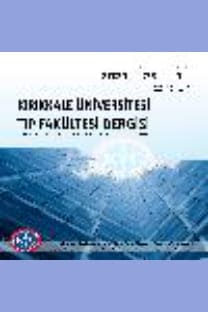Maksiller Sinüs Patolojileri ile Ostium Boyutları Arasındaki İlişkinin Araştırılması: Bir Retrospektif Konik Işınlı Bilgisayarlı Tomografi Çalışması
Konik Işınlı Bilgisayarlı Tomografi, maksiller sinüs, maksiller sinüs ostiumu, patoloji
EVALUATION OF RELATIONSHIP BETWEEN MAXILLARY SINUS PATHOLOGIES AND OSTIUM DIMENSION: A RETROSPECTIVE CONE BEAM COMPUTED TOMOGRAPHY STUDY
___
- 1. Nayak JN, Varalakshmi K, Sangeetha M, Naik S. An anatomical study on location of maxillary sinus ostium and ıt's surgical ımportance. Int J Cur Res Rev. 2014;6(18):1-7.
- 2. Singhal M, Singhal D. Anatomy of accessory maxillary sinus ostium with clinical application. Int J Med Sci Public Health. 2014;3:327-329.
- 3. Capelli M, Gatti P. Radiological Study of Maxillary Sinus using CBCT: Relationship between mucosal thickening and common anatomic variants in chronic rhinosinusitis. J Clin Diagn Res. 2016;10(11):7-10.
- 4. Maillet M, Bowles WR, McClanahan SL, John MT, Ahmad M. Cone-beam computed tomography evaluation of maxillary sinusitis. J Endod. 2011;37(6):753-757.
- 5. Patel K, Chavda SV, Violaris N, Pahor AL. Incidental paranasal sinus inflammatory changes in a British population. J Laryngol Otol. 1996;110(7):649-651.
- 6. Shiki K, Tanaka T, Kito S, Wakasugi-Sato N, Matsumoto-Takeda S, Oda M et al. The significance of cone beam computed tomography for the visualization of anatomical variations and lesions in the maxillary sinus for patients hoping to have dental implant-supported maxillary restorations in a private dental office in Japan. Head Face Med. 2014;10:20.
- 7. Howerton JW, Mora M. Use of conebeam computed tomography in dentistry. General Dentistry. 2007;55:54-7.
- 8. Dau M, Marciak P, Al-Nawas B, Staedt H, Alshiri A, Frerich B et al. Evaluation of symptomatic maxillary sinus pathologies using panoramic radiography and cone beam computed tomography-influence of professional training. Int J Implant Dent. 2017;3(1):10-13.
- 9. Ritter L, Lutz J, Neugebauer J, Scheer M, Dreiseidler T, Zinser MJ et al. Prevalence of pathologic findings in the maxillary sinus in cone-beam computerized tomography. Oral Surg Oral Med Oral Pathol Oral Radiol Endod. 2011;111(5):634-640.
- 10. Da Silva AF, Froes GR Jr, Takeshita WM, Da Fonte JB, De Melo MF, Sousa Melo SL. Prevalence of pathologic findings in the floor of the maxillary sinuses on cone beam computed tomography images. Gen Dent. 2017;65(2):28-32.
- 11. Aksakalli S, Yılmaz BS, Birlik M, Dadasli F, Bolukbasi E. Is there a relationship between maxillary sinus findings and skeletal malocclusion? Turkish J Orthod. 2015;28(3):82-85.
- 12. Carter LC, Calamel A, Haller A, Aguirre A. Seasonal variation in maxillary antral pseudocysts in a general clinic population. Dentomaxillofac Radiol. 1998;27(1):22-24.
- 13. Conner BL, Roach ES, Laster W, Georgitis JW. Magnetic resonance imaging of the paranasal sinuses: frequency and type of abnormalities. Ann Allergy. 1989; 62(5):457-460.
- 14. Block MS, Dastoury K. Prevalence of sinus membrane thickening and association with unhealthy teeth: a retrospective review of 831 consecutive patients with 1,662 cone-beam scans. J Oral Maxillofac Surg. 2014;72(12):2454-2460.
- 15. Vallo J, Suominen-Taipale L, Huumonen S, Soikkonen K, Norblad A. Prevalence of mucosal abnormalities of the maxillary sinus and their relationship to dental disease in panoramic radiography: results from the Health 2000 Health Examination Survey. Oral Surg Oral Med Oral Pathol Oral Radiol Endod. 2010;109(3):80-87.
- 16. Wen SC, Lin YH, Yang YC, Wang HL. The influence of sinus membrane thickness upon membrane perforation during transcrestal sinus lift procedure. Clin Oral Implants Res. 2015; 26(10):1158-1164.
- 17. Yildirim TT, Guncu GN, Goksuluk D, Tozum MD, Colak M, Tozum TF. The effect of demographic and disease variables on Schneiderian membrane thickness and appearance. Oral Surg Oral Med Oral Pathol Oral Radiol. 2017;124(6):568-576.
- 18. Yeung AWK, Tanaka R, Khong PL, von Arx T, Bornstein MM. Frequency, location, and association with dental pathology of mucous retention cysts in the maxillary sinus. A radiographic study using cone beam computed tomography (CBCT). Clin Oral Investig. 2018; 22 (3):1175-1183.
- 19. Khojastepour L, Haghnegahdar A, Khosravifard N. Role of Sinonasal Anatomic Variations in the Development of Maxillary Sinusitis: A Cone Beam CT Analysis. Open Dent J. 2017; 11:367-374.
- 20. Zang H, Wu J, Hu C, Li L, Liu Y, Yu S et al. Study on the correlation between the ostia diameter changes and airflow characteristics in maxillary sinus. Zhonghua Er Bi Yan Hou Tou Jing Wai Ke Za Zhi. 2015;50(10):805-809.
- ISSN: 2148-9645
- Yayın Aralığı: Yılda 3 Sayı
- Başlangıç: 1999
- Yayıncı: KIRIKKALE ÜNİVERSİTESİ KÜTÜPHANE VE DOKÜMANTASYON BAŞKANLIĞI
ACİL SERVİS HEKİMLERİNİN TIBBİ HUKUKİ SORUMLULUKLARI HAKKINDA BİLGİ, TUTUM VE DAVRANIŞLARI
ALİ AYGÜN, Volkan KARABACAK, HASAN SERDAR IŞIK
Erden ATİLLA, Fulya ÖZEL, Pınar ATACA ATİLLA, PERVİN TOPÇUOĞLU, HAMDİ AKAN, MERAL BEKSAÇ, OSMAN İLHAN, MUHİT ÖZCAN, Önder ARSLAN, GÜNHAN GÜRMAN, Selami KOÇAK TOPRAK
ANNELERİN SÜT DİŞLENME İLE İLGİLİ BİLGİ VE DENEYİMLERİNİN DEĞERLENDİRİLMESİ
Kırıkkale Yöresinde İnsan ve Hayvan Kaynaklarından İzole Edilen E. coli O157:H7’nin Prevalansı
TEOMAN ZAFER APAN, Murat YIDIRIM, MEHMET BAŞALAN, AYLİN KASIMOĞLU
ALIŞILMADIK BİR LAVMAN UYGULAMASINA BAĞLI REKTOSİGMOİD İSKEMİ VE PERFORASYON
Ektodermal Displazili Çocuklarda Erken Protetik Tedavi: Üç Olgu Sunumu
FATİH TULUMBACI, Tuğba SERT, MERVE ERKMEN ALMAZ
YOĞUN BAKIMDA İNTOKSİKASYON OLGULARININ RETROSPEKTİF ANALİZİ
GÜLÇİN AYDIN, Muharrem ATASEVER, IŞIN GENÇAY, SELİM ÇOLAK, ÜNASE BÜYÜKKOÇAK
SEVAL BAYRAK, GÜLBAHAR USTAOĞLU, Emine Şebnem KURŞUN ÇAKMAK, CEMAL ATAKAN
